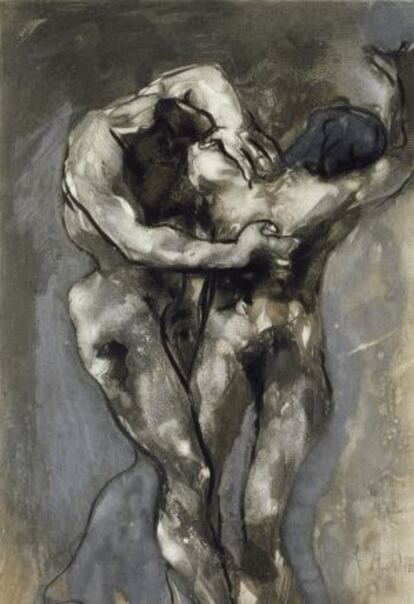Rodin under the radar
Artist's etchings on display in unprecedented show at San Fernando Academy No commercial sponsors agreed to give their support for the exhibition

Patrons of the arts are very particular people, but very necessary nevertheless. In fact, they are downright indispensable if the point is to let creators of art to get on with their work without being bothered by the nasty, irksome details of everyday life. But don't be fooled: it's not like the world of art is in the nurturing arms of a group of selfless individuals. Not at all. The art patron always wants something in return for a generosity that might be genuine or hypocritical.
This something might be social acknowledgement. Or it might be a political favor. Or it might be fast-track access to certain social circles that are theoretically off limits to mere mortals, a bit like the character of Julien Sorel created by Stendhal in The Red and the Black : art patronage can provide access to a world that is in theory not our own.
Let us take the example of Maurice Fenaille. Besides being a mogul of the petroleum industry in late 19th-century France, this individual was also a member of the Académie des Beaux Arts. And why? Because he was an inveterate art collector and a friend of artists, especially Auguste Rodin.
Between his business trips across the globe and his creation and commercialization of lubricants and all sorts of oil-based products (which made him rich), Fenaille bought works from Rodin; he commissioned a piece called Bathers to decorate the interior pool of his mansion in Neuilly; he devoted time to trying to understand Rodin the genius and Rodin the ogre; and he funded what has been known since 1897 as the Album Fenaille , whose 139 disturbing etchings are now hanging at the Academy of Fine Arts of San Fernando in Madrid until November 11, in an exhibition called Figuras de sombras (or, Figures of shadow).
These are popularly known as Rodin's "black drawings," an unsettling saga created over time by the maker of the famous The Thinker and The Burghers of Calais . Their relationship with Goya's Black Paintings is double, at least in this case: first there is the subject matter (Dante's Inferno in Rodin's case and war and disease in that of Goya); and then there is the fact that in November, Goya's Disasters of War , which are the property of the San Fernando Academy, will travel to Bordeaux for display at the Musée d'Aquitaine, which is home to the Album Fenaille .
The album was published in 1897 by Maison Goupil, a pioneer in new techniques for reproducing artistic images. Art democratization was taking its first steps with the multiplication and commercialization of art thanks to photoengraving, a technology created in 1870 by Henri Rousselon and which allowed many people to access a universe hitherto reserved for aristocrats and other wealthy individuals.
There is practically no precedent for it in Spain as regards his facet as a draftsman
Rodin made the drawings for the Fenaille album while he also worked on one of his greatest creations, The Gates of Hell , a colossal, unfinished piece (six meters tall by four meters wide) that takes pride of place at the Musée Rodin in Paris, which was a reply of sorts to the Gates of Heaven sculpted four centuries earlier in Florence by Lorenzo Ghiberti. The Biblical images, as rendered by Rodin, are truly disturbing: specters condemned to torment, lovers carried away by the storm, heretics (the Prophet Mohammed included) getting their guts ripped out, blasphemes feeding the flames, thieves turned into reptiles, corrupt individuals drowning in tar...
Potential visitors to the exhibition should be aware that it has only been seen in Tokyo, Rome and Florence before this, and that there is practically no precedent for it in Spain, at least if we consider Rodin's facet as a draftsman. Only a show organized 10 years ago in Salamanca could serve as a reference.
"It's unbelievable - all we were asking for was 8,000 euros" says gallery chief
And yet an exhibition of this scope could go by almost unnoticed in the Spanish capital. There will be no billboards advertising it nor any ads taken out in newspapers. Visitors will not be able to purchase the catalogue, as there isn't one - potential sponsors of the show were unwilling to give their support. "It's unbelievable - all we were asking for was 8,000 euros," says Juan Bordes, head of the National Etching section of the San Fernando Academy. "But these days, lenders would rather pay compensation packages to their outgoing executives than support culture."
Art patrons, after all, are very particular people.
Figuras de sombras . Until November 11 at Salas de Calcografía Nacional, Real Academia de Bellas Artes de San Fernando, c/ Alcalá 13, Madrid.
Art, genius, love and torment
François-Auguste René Rodin (Paris, 1840-Meudon, 1917) is a capital name in the history of sculpture. The first modern artist, as some critics have called him, studied human anatomy obsessively before interpreting it - and deforming it - from Impressionist and decidedly un-academic approaches, which earned him the initial wrath of part of the art world.
Rodin's major works are The Thinker , The Burghers of Calais , the Monument to Balzac , The Gates of Hell and one of the best-known sculptures ever made, The Kiss.
A genius with an explosive character, the artist maintained an intense if tormented relationship with pupil Camille Claudel, a sculptor in her own right, whom he ultimately abandoned and who was institutionalized at a psychiatric hospital. A 1988 movie starring Gérard Depardieu and Isabelle Adjani, called simply Camille Claudel , tells that other story from Rodin's life
Tu suscripción se está usando en otro dispositivo
¿Quieres añadir otro usuario a tu suscripción?
Si continúas leyendo en este dispositivo, no se podrá leer en el otro.
FlechaTu suscripción se está usando en otro dispositivo y solo puedes acceder a EL PAÍS desde un dispositivo a la vez.
Si quieres compartir tu cuenta, cambia tu suscripción a la modalidad Premium, así podrás añadir otro usuario. Cada uno accederá con su propia cuenta de email, lo que os permitirá personalizar vuestra experiencia en EL PAÍS.
¿Tienes una suscripción de empresa? Accede aquí para contratar más cuentas.
En el caso de no saber quién está usando tu cuenta, te recomendamos cambiar tu contraseña aquí.
Si decides continuar compartiendo tu cuenta, este mensaje se mostrará en tu dispositivo y en el de la otra persona que está usando tu cuenta de forma indefinida, afectando a tu experiencia de lectura. Puedes consultar aquí los términos y condiciones de la suscripción digital.









































